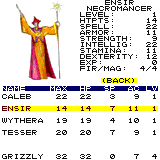

|
Selecting the STATISTICS menu option will view detailed stats
for the currently selected character. From the statistics screen
you may click BACK to return to the Character Menu, or click on an
alternate character to view their statistics. The statistics screen
shows the following character attributes: |
- Level - The character's level. Characters may be promoted
to higher levels at the guild after they gain enough experience
points through winning combat. Higher level characters are more
likely to succeed at running from, defending against, and attacking
lower level monsters. And every four advances in character level
gives that character access to new spells. If you think you have
fought enough monsters and gained enough experience to advance
a level, visit the Review Council for a level promotion.
- Hit Points - Indicates the character's maximum
hit points (HP). The hit point is the basic unit of life in the game.
When your characters are attacked, damage taken is reflected by a
reduction of their HP. If any character's HP falls to zero, then they
die, and must be resurrected (in the temple, or using the advanced
Sorcerer's resurrect spell). You can also heal your characters by
sleeping, casting spells or using a spell casting device, or visiting
a temple. The troglodyte class also has the ability to naturally
heal himself slowly over time, and there are many other ways to heal
characters hidden in the game.
- Spell Points- Indicates the
character's maximum spell points (SP). Spell points are
spent each time the character casts a spell. See the spells
section of this manual for details. Spell points can be recharged
at the temple, by casting certain necromancer spells during combat, or
by exposing the character to sunlight. Mages regenerate spell points
twice as fast as fighting classes under the sun. Note, that there are
other ways to re-charge your party's SP, hidden in the game.
- Resist Fire / Resist Magic - These attributes
indicate how well a character is protected against fire and magic
based attacks. Resistances are not used to determine whether a
monster's attack is successful or not, but it is used to determine
what percent of a successful hit's damage is inflicted on the
character. So if a monster's attack misses a character, resistances
play no role in the combat. But in the case that a monster's attack
hits a character, then the damage inflicted is reduced according to
the character's resistance. For example, a fire-based attack that
normally does 10 damage would only inflict 8 damage on a character
that has a fire resistance of 20%.
- Armor Class (AC) - Your character's
armor class indicates how well he or she is protected during combat.
Lower armor class indicates the character is less likely to be hit
when attacked, but it is not an indication of how much damage the
character will take when hit. You can lower your character's armor
class by equipping different kinds of armor, or other special items.
- Strength - Your character's strength is used to help
determine the amount of damage he or she is capable of inflicting
using any hand-to-hand weapon such. Strength is also a
factor in determining what kind of armor and weapons the character is
able to use. Weaker characters, like the sorcerer and wizard have low
strength, and therefore will not meet the requirements for equipping
better armor or hand-to-hand weapons.
- Intelligence - Intelligence is used to determine what kind
of spell weapons the character can equip or use. Characters with low
intelligence are not able to use or equip the best magical weapons or
artifacts. Intelligence is also used to determine how many SP are
rewarded to the character at his or her level promotions. Characters
with higher intelligence are rewarded with more SP at promotion.
- Stamina - This attribute is used to determine how many HP
are rewarded at his or her promotion. Characters with higher stamina
gain more HP at their next promotion.
- Dexterity - This attribute is used to determine the order
in which the character attacks during combat. Characters with high
dexterity attack before characters or monsters with lower dexterity.
A character's dexterity is also used to determine which bow-class weapons a character can
use (such as a throwing knife, spear, bow or crossbow). Characters
with higher dexterity will be able to use and equip better bow class
weapons.
- Experience - The character's experience points. Experience
points are rewarded only at the end of battles in which your party
emerges victorious. If you run from combat, no partial experience is given out.
Furthermore, characters killed during combat will not be rewarded any
experience for that round. More and more experience is required for
each subsequent promotion, so you should always push your party into
new territory so you can find more difficult monsters to fight that you
will help you earn higher experience.
|
|
